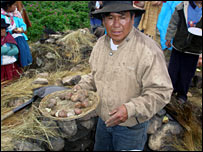Peru's potato passion goes global
February 8, 2008 - BBC News
By Dan Collyns, BBC News, Ayacucho, Peru
 (right) Peruvians are very proud of their potatoes
(right) Peruvians are very proud of their potatoes
At harvest time in the highland village of Paucho, the first crop of potatoes are baked in a hole in the ground covered with hot rocks, in a ceremony called Watia - a homage to Pacha Mama, or Mother Earth.
For thousands of years, the potato has been the staple diet of the people of the Andes.
It was first cultivated on the Altiplano of modern-day Peru and Bolivia, and Peru still has some 2,800 varieties of potato, more than any other country.
Like many people, I took the humble spud for granted, but after the launch of the UN Year of the Potato in Ayacucho in the Peruvian Andes, I am repentant at my lack of reverence for the third biggest food staple in the world.
Boost consumption
I have never seen a vegetable invoke such high passions and poetry.
It was the theme for a seamless succession of carnival floats, colourful costumes, and traditional dance and music. All this was punctuated by cries of "la papa es Peruana" - "the potato is Peruvian", just in case anyone forgot.
Despite this, consumption of the potato in Peru has dropped to half that of many European countries, with many Peruvians turning to rice or bread.
 (right) Many potato-producing communities are very poor
(right) Many potato-producing communities are very poor
But internationally high food prices, especially wheat - 80% of which is imported in Peru - are causing hardship for the country's poor, who make up almost half the population.
Peru's agriculture minister, Ismael Benavides, says the native potato is the answer.
The government is trying to boost its consumption by encouraging more people to eat bread baked with potato flour, starting with schoolchildren and prisoners.
"When I went to the UN in October to launch the International Year of the Potato somebody from an Eastern European country, Ukraine I think, said to me 'I didn't realise that potatoes came from Peru'. That showed me that we had to claim our place," Mr Benavides said at the festival.
"The potato is very important in the diet worldwide and in this age of rising commodity prices... a number of countries, such as China and India, are looking to double or triple their production."
Marketing tactics
Can Peru benefit from this projected surge in consumption?
"The paradox that we find today is that it is precisely those communities which have developed and given the world the potato are some of the poorest communities in the Andean chain," says Pamela Anderson, director of the International Potato Centre, based in Lima.
"So part of what we do at the International Potato Centre is to take the native potato and really begin seriously and systematically marketing it, so that these small, poor farmers can use the native potato as a pathway out of poverty.
 The International Potato Centre is working with the government to drive the internal consumption of native potatoes, which come in a rich variety of colours, shapes and flavours.
The International Potato Centre is working with the government to drive the internal consumption of native potatoes, which come in a rich variety of colours, shapes and flavours.
The idea is not only to help poor rural communities, but also the 70% of Peru's population that lives in urban centres.
"The price of bread has gone up and I just don't have the money to buy it as I used to," says Hermelinda Azurin, who supports her two daughters working as a maid in Lima.
"A kilo of potato bread is 3.4 soles ($1.16) whereas normal bread has gone up to 5.40 soles ($1.84) in my neighbourhood. A kilo of potatoes is just 70 centimos ($0.23). Nowadays we eat potatoes every day in my family."
The Peruvian government is also looking at exporting native potatoes. They are exotic-looking, organic and have vitamins and amino acids that regular white potatoes do not have.
"We feel the quality of this product should have a market abroad, especially as we are opening markets with the US, Canada and we hope soon with the European Union," says Mr Benavides.
"These would fall under what is called fair trade, so we feel there's great opportunities for these potatoes, native in particular."
'Infinite variety'
But it is precisely those new markets and free trade deals which many Peruvian farmers believe will mean they will have to compete unfairly with agricultural imports.
Mario Tapia, an agronomist who specialises in Andean crops, says a lack of investment in infrastructure is one part of the problem.
 (right) Colourful potatoes are seen as a gastronomic treat abroad
(right) Colourful potatoes are seen as a gastronomic treat abroad
"The potato yields are not so high because there is not high investment in the production, so to compete with farmers who have subsidies in their own countries will not be fair for those farmers in the highlands," he says.
With or without an export market, the government plans to boost the internal potato market and give technical assistance to the 1.8m potato growers in Peru.
In the gastronomic world, the native potato has enthusiastic advocates.
Peruvian restaurateur Isabel Alvarez says its "infinite variety of colours, textures, shapes and flavours" has prompted positive reactions in Europe.
"The potato is a world in itself, and it is a gastronomic world which we've only begun to explore," she says.
With gastronomic plaudits and its spiritual place in Andean culture assured, the question remains: can Peru's gift to the world now be used to help those who gave it to us in the first place?